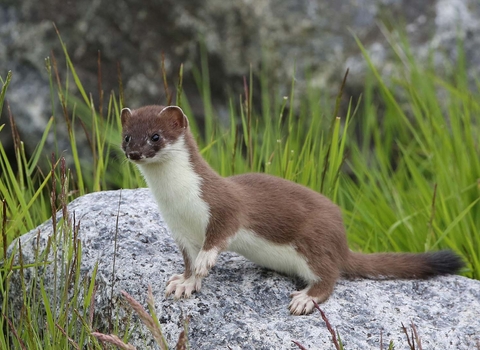
Stoat © Margaret Holland

©Richard Steel/2020VISION
Stoat
The stoat is a small mustelid, related to the weasel and otter. It has an orange body, black-tipped tail and distinctive bounding gait. Spot it on grassland, heaths and in woodlands across the UK.
Scientific name
Mustela ermineaWhen to see
January to DecemberSpecies information
About
The stoat is a small predator, with a long, low-slung body that makes it particularly well suited to hunting small rodents and rabbits. It can easily kill an adult rabbit, which is much larger than itself, with a bite to the base of the skull. Stoats are active by day and night, and are easiest to spot in open habitats, such as sand dunes, grassland and heathland. They mate in summer, but delay implantation of the fertilised egg until the spring of the following year. They have one litter of six to twelve kits a year.How to identify
The stoat has an orangey-brown back, a creamy white throat and belly, and a black-tipped tail. It is larger than the similar weasel, has a longer tail and has a distinctive bounding gait, arching its back as it moves; weasels do not bound, but run close to the ground.Distribution
Widespread, found throughout the country, although absent from some Scottish islands, the Isles of Scilly and most of the Channel Islands.In our area
Join today
Join thousands of members who are already protecting Cumbria's wildlife & wild places. More about membership
Did you know?
In the winter, stoats living in colder climes may turn almost completely white, with just a black tip to the tail. This is known as 'ermine' and the fur is extra dense to help them keep warm. Stoats in warmer parts of the UK may not change colour at all, or may take on a 'patchy' appearance.Join today
Join thousands of members who are already protecting Cumbria's wildlife & wild places. More about membership
